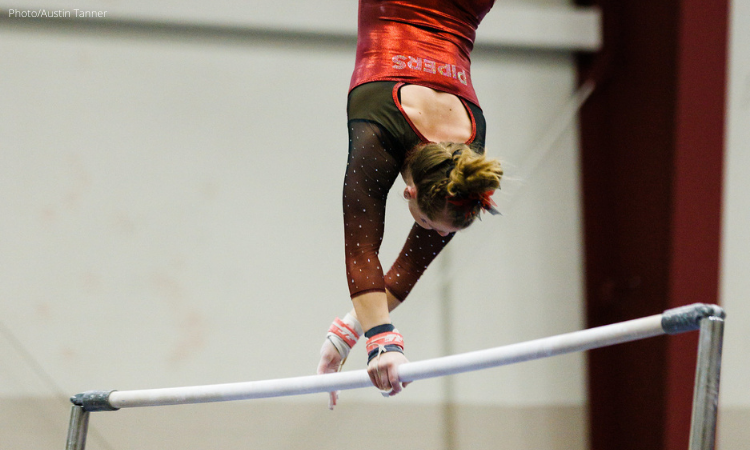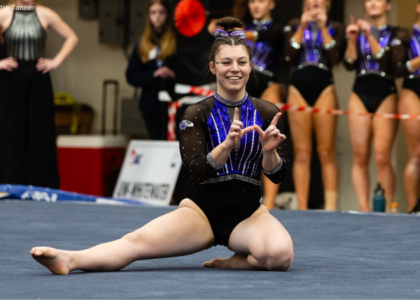If you asked any gymnast, “What’s your favorite event?” you’d likely get a variety of answers. However, when looking at trends in Division III event scoring, one of these things is not quite like the others. Bars has historically been the lowest scoring event across all Division III teams. It’s a curious conundrum that must have a cause. Is it recruiting or start values and up to level difficulties? Is it that there just aren’t enough bars stars to go around? Is it something else entirely? Maybe today we can get one step closer to finding the culprit, or better yet, try to find a solution.
Beginning with the 2020 competition season, the base start value for bars, beam and floor routines in college was lowered from 9.5 to 9.4. That means that athletes have to earn an extra tenth of bonus on each event to start from a 10.0. Single bar releases were also awarded an extra tenth of bonus to incentivize doing the “harder” skills. This allowed for greater differentiation between routines with “easier” routine composition. Sounds like a great idea.
However, this had a larger impact on smaller schools that have fewer athletes performing high-flying releases. Since then, there have been two choices: recruit specifically for big releases or try to find an extra tenth of bonus hidden in the code of points.
The top schools in the NCGA have been able to make the switch to intentionally recruiting for single bar releases. Tkatchevs, Jaegers and Markelovs can be found in increasing numbers in Division III lineups, including those of Brockport, UW-La Crosse and UW-Oshkosh. Sometimes the extra risk pays off; other times it doesn’t. However, the opportunity for bars scoring to hang with the other events is there.
Other teams have added extra tenths through turning skill connections, but with more skills come more opportunities for deductions. Single bar releases make the transition to the new start value rules easier, but that’s assuming there are enough athletes capable of executing these harder skills to go around.
The refrain, “I can’t wait until I get to college, so I don’t have to do bars ever again” is a common one. One of the perks of college gymnastics is the concept of specializing. It’s no longer a requirement for every athlete to be an all-arounder. If splitting a four inch piece of metal covered in leather was never your favorite pastime, you can retire from beam. If running and jumping onto an inanimate object backward is terrifying, vault’s gone forever. If rhythm is just too hard to maintain for a minute and thirty seconds, no more floor for you. But the first to go? Bars. Anyone who has taken a bar to the rib a time or two can’t blame someone for hanging up the grips. It’s brutal.
So many bars retirements leave fewer athletes to spread across 82 total collegiate gymnastics programs, 62 of which can offer some sort of athletic scholarship. Without the ability to offer monetary incentive to attend the school, Division III programs have to get creative when searching for strong bar workers.
Kasey Crawford, La Crosse head coach, says she looks for “diamonds in the rough” when recruiting. These are the athletes that may have missed the main recruiting time frame for larger schools or have yet to reach their peak. Crawford emphasizes the need to look nationwide for athletes that will both fill the lineups and fit in with the Eagles’ team culture. This year, La Crosse’s roster even extends to two members from Canada.
Crawford points to the priority of recruiting strong bar workers across all three divisions as making it more difficult to find athletes who both are strong on the event and who will fit the team dynamic created at La Crosse. The Eagles try to accomplish this by broadening the search parameters. This hunt starts by seeking athletes who are strong on vault and bars, with preference toward “an athlete that has a desire to do all four events, or if not, then a desire to contribute on three events,” according to Crawford.
When it comes to bars-specific attributes, big releases, bonus endings, like connections into dismounts, and E dismounts are the main drawing factors. Being as close to a 10.0 start value as possible is the goal. Solid lines and clean form are the icing on the cake. Oftentimes Division III recruiting does not involve looking for the ready-made athlete. Instead these coaches are looking for someone with the potential to develop into a well rounded athlete during their four years. In many ways, that requires an even more precise eye when going through the recruiting process.
The athlete’s attitude has as much impact as her ability to do gymnastics. Although the goal is to have a minimum of six 10.0 start value bar routines, Crawford is not willing to sacrifice team culture for a routine. It’s clear that the team’s recruiting philosophy is working, as La Crosse has continued to move up the regular season ranks since the rule change.
It is clear that Division III bars scores are impacted by the reduced base start value, high demand for strong bar workers across all divisions and the inability to offer student athletes an athletic scholarship. However, looking for athletes with untapped potential across the country and even the globe can help bridge the scoring gap.
READ THIS NEXT: Limited Leotard Budgets for Division III Programs Force Creative Thinking
Article by Tavia Smith
Like what you see? Consider donating to support our efforts throughout the year! [wpedon id=”13158″]





Nice article! I enjoyed the insight on the approach to building a bars squad under the current rules, and not just from the perspective of a perennial top 10 team. Thanks.